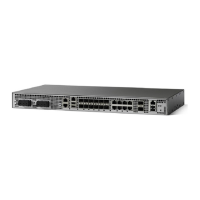4
Cisco IOS XE 3S Release Notes for the Cisco ASR 903 Router
OL-26630-12
Chapter
New Software Features in Cisco IOS XE Release 3.7(0)S
• GOLD—Generic Online Diagnostic (GOLD) is a health monitoring feature implemented on the
Cisco ASR 903 Router. The GOLD functionality is developed to provide online diagnostic
capabilities that run at bootup, in the background on a periodic basis, or based on demand from the
CLI. For more information, see
http://www.cisco.com/en/US/docs/wireless/asr_900/feature/guides/GOLD.html.
• Hot Standby Pseudowire Support—The Hot Standby Pseudowire feature provides faster failover of
a backup pseudowire and reduced traffic loss during failover by setting the backup pseudowire to a
hot standby state, such that it can immediately take over if the primary pseudowire fails. This feature
is supported for Ethernet only; TDM and ATM interfaces are not supported. For more information,
see:
–
http://www.cisco.com/en/US/docs/routers/7600/install_config/ES40_config_guide/es40_chap6.
html.
–
http://www.cisco.com/en/US/docs/ios/12_0s/feature/guide/fspseudo.html
–
http://www.cisco.com/en/US/partner/docs/ios/mpls/configuration/guide/mp_hspw_for_atm.html
#wp1054150
• Hybrid Clocking Support—Hybrid clocking mode that uses clock frequency obtained from the
synchronous Ethernet port while using phase (ToD or 1PPS) obtained using PTP. The combination
of multiple time and phase sources for the same master clock improves performance over using PTP
alone. The router can act as a hybrid clock in both master ordinary clock and slave ordinary clock.
For more information, see
http://www.cisco.com/en/US/docs/routers/asr903/software/guide/chassis/Release3.7.0S/ASR903-
Chassis-SW-37.html.
• IPv6 ACL—IPv6 Access Control Lists (ACLs) determine what traffic is blocked and what traffic is
forwarded at device interfaces. ACLs allow filtering based on source and destination addresses,
inbound and outbound to a specific interface. For more information, see
http://www.cisco.com/en/US/docs/wireless/asr_900/feature/guides/IPv6_ACL.html.
• Layer 2 QoS for ATM—This feature introduces support for support cbr and vbr on ATM interfaces.
For more information, see
http://www.cisco.com/en/US/partner/docs/ios-xml/ios/mp_l2_vpns/configuration/xe-3s/qos-atm-v
p-support-xe.html
• Link Path Through—This feature enables a local EoMPLS PE router to detect a failure in the path
between the remote PE and CE routers. The local PE router propagates the failure to the local CE
router such that it brings down the pseudowire connection and can more quickly reestablish the
connection when the remote CE-PE connection is restored. This feature is enabled automatically and
does not introduce any new CLI commands.
• MAC Address Security for EVC Bridge-Domain—MAC address security for EVCs. Provides the
capability to control and filter the MAC address learning behavior at the granularity of a single EVC
service instance. For more information, see:
–
http://www.cisco.com/en/US/docs/ios-xml/ios/cether/configuration/xe-3s/asr903/ce-mac-addlmt
-bdsin.html
–
http://www.cisco.com/en/US/docs/ios-xml/ios/cether/configuration/xe-3s/ce-mac-addlmt-bdsin.
html
• MAC Limiting—Mac address limiting per bridge-domain restricts the number of MAC addresses
that the router learns in bridge-domain on an EFP, pseudowire or switch port. For more information,
see http://www.cisco.com/en/US/docs/wireless/asr_900/feature/guides/mac_limiting.html.

